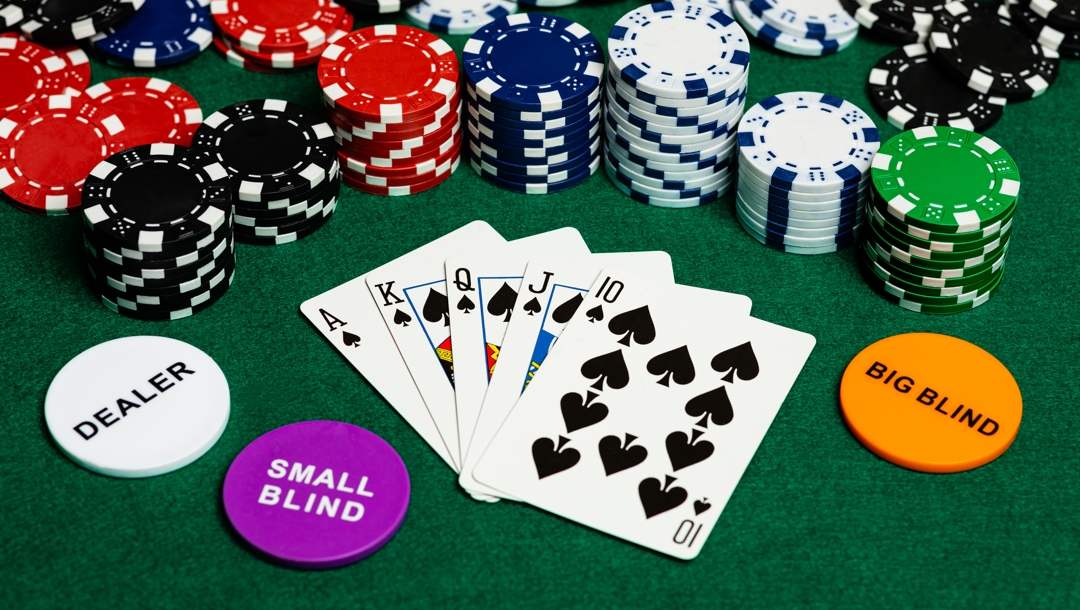
Have you ever found yourself in a battle of the blinds? It’s a situation that many poker players are unprepared for purely because of how unexpected it is. After all, on average, most hands will see action long before it folds to the blinds. That said, it happens more often than you may think, especially in online poker tournaments. Rather than risk being taken by surprise, let’s look at what you can do if you find yourself playing the small blind versus the big blind or vice versa.
What are blinds in poker?
Poker blinds are mandatory bets placed by players in the small blind and big blind positions, so knowing how they work is an essential basic poker strategy. Poker blind rules put the big blind one position directly to the left of the small blind at the beginning of each hand. The blinds put in fixed bets before play starts. For instance, a $2/$5 cash game would see the small blind place a $2 bet and the big blind $5. After that, preflop betting begins, starting with the player “under the gun,” that is, directly to the left of the big blind. This player can call the big blind, raise or fold.
The action then moves clockwise around the table, with the small blind and big blind being the last two to act. For every betting round that follows, the small blind starts the action. If the small blind is out, the next player to the left begins. When the hand is over, the blinds move one position clockwise and it’s time for a new hand. The primary disadvantage of playing the blinds is that you’re always out of position after the flop.
The battle of the blinds
In online poker, blind-versus-blind action occurs when all the other players fold before the flop, leaving the small and big poker blinds to battle it out. In this scenario, the big blind is always in position, meaning that the small blind has to act first every time. As a result, the small blind can take the initiative by open raising, but the big blind can defend from position. There are two general strategic approaches in this situation. The first is a simpler raise-only strategy that’s good for beginners. The second is a more advanced mixed limp-raise strategy. We’ll look at both of them in turn, applying the mixed strategy to 100BB, 40BB and 15BB games.
Small blind vs. big blind: a simplified approach

A simplified small blind strategy can serve you well in small-stakes games, should it come down to a battle of the blinds. Basically, if the flop is advantageous for your range, c-bet every single time from the small blind. This would include nine-high (or better) boards with rainbow (the cards are all different suits) or two-tone (the cards are from two different suits) textures.
If the flop is very bad for your hand, check every time. This would include monotone boards (all one suit) and boards that are eight-high or lower.
If the big blind looks weak, exploit them by c-betting every time the flop comes monotone or poorly connected (say, eight-three-two).
100 BB mixed blind strategy
So you’re 100 big blinds deep in a cash game and you’re playing from the small blind against the big blind. In this situation, you definitely want to get into the pot – and the best way to do this is to adopt a mixed limp-raise strategy. Play with a very wide range, but only raise with the very strongest hands, otherwise get comfortable with being a calling station.
In the big blind position, you’ll want to play in a very polarized way, iso-raising from position with a fairly broad range and using your strong hands to build the pot. Don’t be so polarized that you give the game away, though. Sometimes you’ll need to improvise your strategy!
In response, the small blind should 3-bet with very strong hands (nine-nine and better) as well as any hands with an ace or a king. Otherwise, it’s best to call with a fairly broad range, even down to seven-four and ten-two.
40BB mixed blind strategy
When it’s blind-versus-blind and you’re 40 big blinds deep, there’s less money on the table, which means more scope to raise from the small blind. The main idea is still to build the pot with your strongest hands, but now you want to open up your range to give yourself a chance to connect with different board types.
The big blind’s response should be 3-bet only with the strongest hands, otherwise call with a very wide range. If the small blind limps, iso-bet with a polarized range and check back with hands that you want to play.
15 BB mixed blind strategy
Things are quite different when you’re down to 15 big blinds. The small blind’s best strategy is now to go all in with the majority of suited and unsuited aces, otherwise limp in with stronger and weaker hands. Keeping your very strongest hands in your limping range will help you call off your opponent if they go all in.
If the small blind shoves, the big blind should do a standard equity calculation and respond accordingly. Against a limp, you should have a differentiated response, including shoves, raises and checks with different hand types at varied frequencies. Iso-raise with your strongest hands and consider shoving with smaller pocket pairs as well as ace-two unsuited through to ace-jack unsuited.
Common pitfalls to avoid

There are common mistakes that players often make in the battle of the blinds. Memorizing them will help you to avoid them and notice when your opponent is making them.
The first is overfolding to big blind aggression from the small blind. All too often, players give up marginal hands that they could take the flop with. The solution is to call with a fairly broad range of hands.
The second is when players in the big blind overfold to a small opening raise from the small blind. Small blind players will exploit this weakness mercilessly by opening a large number of hands, so rather open up your calling range than keep folding.
Chopping the blinds
Sometimes, you’ll have a situation where all the other players fold to the blinds before the flop comes. Some live games will then allow you to chop the blinds, which means that you take them off the table and start a new hand. The advantage of chopping the blinds is that you don’t have to pay rake after the flop. This can work out to your advantage in low-stakes games with a rake of 25% of the pot. However, if the stakes are high or the rake is comparatively low, you’re better off gearing up for battle!
Position yourself for top poker action at BetMGM
Looking to advance up the online poker rankings? Register an account at BetMGM and get your poker hand in with cash games, sit and gos and online poker tournaments for every budget and skill level. Enjoy a streamlined gaming experience on our online poker app and meet like-minded players from all over. Looking for some fun in between sessions? Our online casino has a broad range of online slots, casino table games and live dealer games for your entertainment. Expand your fun horizon at BetMGM!
Are you ready for a poker blind battle? Position yourself for success with our blind strategy tips and prepare for small blind vs big blind action.


